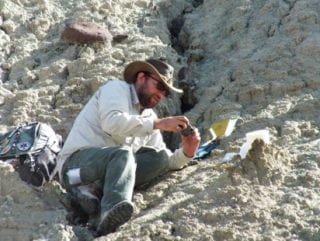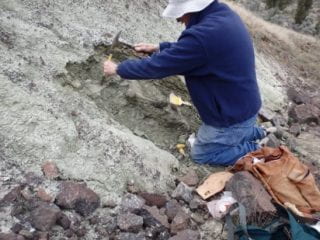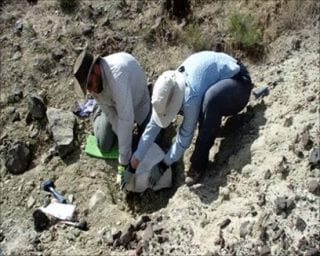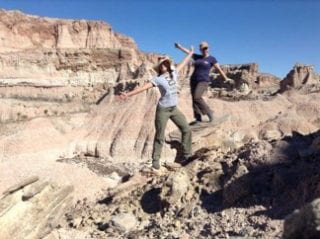Notes from the Field
Paleontologist and University of Arkansas PhD candidate Danielle Oberg has shared some tips and photographs from her time in the field – explore the tabs below!
Be aware that there are legal limitations in the state on what fossils you can collect and where. For instance, most vertebrate fossils are highly protected. If you find vertebrate fossils, you should contact the Arkansas Geological Survey or a natural history museum such as the University of Arkansas Museum. Fossils are a part of Arkansas’ natural history, so keeping a very rare and important fossil prevents others from knowing this history.
For a full rundown on responsible and safe fossil collecting, be sure to check out the Arkansas Geological Survey’s awesome guide.
Safety

Female paleontologist photographing a lizard. Note that she has a rain jacket, water bottles full of water, a field pouch with her notebook, a digital camera, and a backpack with her rock hammer, extra water, fossil collecting supplies and lunch. Photo by N.A. Famoso, 2015.

Equipment carried by paleontologists when looking for and excavating fossils. There is a plaster jacket at the bottom. Photo by N.A. Famoso, 2016.
Maps

Paleontologists reading a geologic map to find fossiliferous outcrops in the country of Kyrgyzstan (photo by D.M. Reuter, 2019).
Notes
When you find a fossil, you will be very excited. BEFORE you pick up that fossil, make sure you take some notes! This is the most important part of fossil collecting.
Consider downloading an app on your cellphone to keep track of important fossil information too!
- Apps such as Rockd will give you your exact GPS position and even tell you which rock formation you are in.
- Apps like iNaturalist allow you to record and share your fossil discoveries with other people around the world.

Female paleontologist taking notes on an outcrop in the John Day Formation, OR. Photo by N.A. Famoso, 2016.
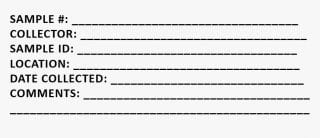
Example sample collection label to help record your finds.
Collecting
Once you have taken sufficient notes, collect that fossil! Carefully remove it from the Earth so you do not damage it. Here’s some tips:
- When collecting, make sure you have a way to bring your fossils home. You can use sample bags like Ziplock bags and buckets/cardboard boxes for collection.
- Make sure you have a sample collection label to keep with each of your collected fossils, so you do not lose any information.
- Big fossils may require more work.
- If your fossils are wet, put them in a box or bucket so they can dry. Wet fossils can get moldy if not dried properly.
- If your fossils are crumbly and falling apart, take pictures of them before collecting so you remember what they look like. Wrap up the fossil in some toilet paper or paper towels and cover it in aluminum foil so you do not lose any pieces.
Female paleontologist excavating a rhino fossil wrapped in a plaster jacket from the John Day Formation, OR. Photo by N.A. Famoso, 2016.
Two paleontologists looking for microfossils in the Hell Creek Formation, MT. Photo by L. DeBey, 2014.
Two paleontologists looking for fossils in an ash tuff in the Hell Creek Formation, MT. Photo by L. DeBey, 2014.
Paleontologist photographing fossils from the John Day Formation, OR. Photo by T. Fremd, 2014.
Paleontologist excavating fossils from the John Day Formation, OR with a rock hammer and chisel. Photo by N.A. Famoso, 2016.
Paleontologists flipping a plaster jacket containing a rhino from the John Day Formation, OR. Video by N.A. Famoso, 2016.
Share!
Remember to take lots of pictures while collecting fossils and share them on social media! Tag the Museum at @uarkmuseum on Facebook and Instagram!
Paleontologists collecting a Triceratops skull from the Hell Creek Formation, MT. Photo by D.E. Oberg, 2014.
Paleontologist collecting a Miocene age rhino jaw fragment from NV. Photo by E.B. Davis, 2017.
Paleontologists posing on an outcrop in TX. Photo by A. Atwater, 2016.
Canine paleontologist finding trilobite fossils in Oak Springs, NV. Photo by M. Wetherell, 2018.



